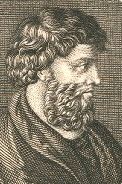
Aristoxenus
370 - 304BC
Aristoxenus, an Aristotelian philosopher, argued that musical intervals should be classified by their effects on listeners as opposed to merely examining their mathematical ratios which was contrary to the Pythagorean. This notion by Aristoxenus, brought the scientific study of music into the mind, followed by the first psychophysics experiments at the dawn of experimental psychology, which mapped changes in the physical world onto changes in the psychological world.
Aristoxenus, known in antiquity as 'o mousikos' ( the Musician), was born in Calabria, at Tarentum, Italy. A Greek Peripatetic philosopher, and a pupil of Aristotle. Most of his writings, which dealt with philosophy, ethics and music, have been lost, but one musical treatise, Elements of Harmony, survives incomplete, as well as some fragments concerning rhythm and meter.
Aristoxenus sought to separate the study of music from that of both physics and mathematics. He refused to make use of any ratios in his treatise, distinctly contra the Pythagoreans, and he also spoke of the raising and lowering of pitch in terms of tension and relaxation, which in his day would admit of no exact numerical measurement, rather than in terms of string-length, from which ratios could be calculated.
In his Elements of Harmony, Aristoxenus attempted a complete and systematic exposition of music. The first book contains an explanation of the genera of Greek music, and also of their species; this is followed by some general definitions of terms, particularly those of sound, interval, and system. In the second book Aristoxenus divides music into seven parts, which he takes to be: the genera, intervals, sounds, systems, tones or modes, mutations, and melopoeia. The remainder of the work is taken up with a discussion of the many parts of music according to the order which he had himself prescribed.
Aristoxenus rejected the opinion of the Pythagoreans that arithmetic rules were the ultimate judge of intervals and that in every system there must be found a mathematical coincidence before such a system can be said to be harmonic. In his second book he asserted that "by the hearing we judge of the magnitude of an interval, and by the understanding we consider its many powers." And further he wrote, "that the nature of melody is best discovered by the perception of sense, and is retained by memory; and that there is no other way of arriving at the knowledge of music;" and though, he wrote, "others affirm that it is by the study of instruments that we attain this knowledge;" this, he wrote, is talking wildly, "for just as it is not necessary for him who writes an Iambic to attend to the arithmetical proportions of the feet of which it is composed, so it is not necessary for him who writes a Phrygian song to attend to the ratios of the sounds proper thereto."
Thus the nature of Aristoxenus' scales and genera deviated sharply from his predecessors. Aristoxenus introduced a radically different model for creating scales. Instead of using discrete ratios to place intervals, he used continuously variable quantities. Hence the structuring of his tetrachords and the resulting scales have other qualities of consonance.
